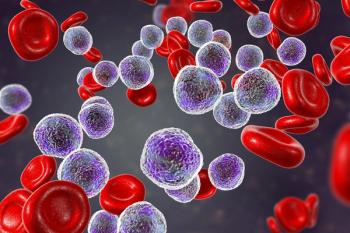
Evidence Shows High Inter- and Intra-Reader Agreement With 18F-rhPSMA-7.3 PET/CT in Recurrent Prostate Cancer
Data from the SPOTLIGHT trial indicate agreement among trained PET readers was highly concordant with use of 18F-rhPSMA-7.3 imaging for recurrent prostate cancer.
Use of 18F-rhPSMA-7.3 PET/CT resulted in pairwise inter-reader agreement of more than 75% overall and intra-reader agreement of more than 85% overall, according to reproducibility results of the phase 3 SPOTLIGHT trial (NCT04186845) that were presented at the
Across the 3 blinded independent central PET readers who participated in the analysis, the highest level of agreement occurred in the pelvic lymph node region with concordance of 87%.
“Inter- and intra-reader agreement for the interpretation of 18F-rhPSMA-7.3 scans was high across 3 blind readers who had completed all identical 18F-rhPSMA-7.3 training,” Philip Kuo, MD, PhD, professor of medical imaging, biomedical engineering, and medicine at the University of Arizona College of Medicine in Tucson, said during a presentation of the data. “The high reproducibility for the extra-prostatic regions is clinically valuable due to the potential for these findings to influence patient Management.
Updated findings from SPOTLIGHT have demonstrated utility of the investigational prostate‐specific membrane antigen (PSMA)–targeted radiohybrid (rh)
Patients treated on the trial who were over 18 years of age, had prior curative intent treatment for localized prostate cancer, had elevated prostate-specific antigen levels suspicious for biochemical recurrence, and were eligible for curative intent salvage therapy were administered 18F-rhPSMA-7.3 at 296 MBq/8 mCi with PET/CT conducted 50 to 70 minutes post-injection. The 3 readers who analyzed the images had completed 18F-rhPSMA-7.3 scan interpretation training.
For inter-reader agreement, 3 regions of prostate/prostate bed, pelvic lymph nodes, and extra-pelvic sites were evaluated, with pairwise agreement between any 2 readers assessed using Cohen’s k coefficient and overall agreement by Fleiss’ k coefficient. For intra-reader agreement, 20% of randomly selected images were re-read by each reader and agreement was assessed using Cohen’s k coefficient, with a 4-week wash-out period between the original and repeat reads.
Pairwise inter-reader comparisons were consistently above 80% in the pelvic lymph node (Fleiss k coefficient, 0.73; 95% CI, 0.67-0.78) and extra-pelvic sites (Fleiss k coefficient, 0.66; 95% CI, 0.60-0.72), although agreement in the prostate bed ranged from approximately 59% to 81% (Fleiss k coefficient, 0.40; 95% CI, 0.33-0.46).
“There was more disagreement in the prostate/prostate bed region. For those who look at PSMA-PET imaging, this is probably not surprising, particularly in this patient population of biochemical recurrence with very early PSA bumps in some patients,” Kuo said. “There is very high agreement when you go for pelvic lymph nodes and other extra pelvic sites across the board [among] all 3 readers.”
Intra-reader agreement was consistently high in the prostate/prostate bed, pelvic lymph node, and extra-pelvic regions for reader 1 at 84.6%, 91.0%, and 96.2%, respectively, for an overall Cohen’s k coefficient of 0.46 (95% CI, 0.10-0.82); reader 2 at 89.7%, 93.6%, and 85.9%, for an overall Cohen’s k coefficient of 0.73 (95% CI, 0.57-0.89); and reader 3 at 80.8%, 87.2%, and 92.3%, for an overall Cohen’s k coefficient of 0.58 (95% CI, 0.36-0.80).
Kuo pointed out that the Fleiss k coefficient for inter-reader agreement was 0.38 (95% CI, 0.30-0.46), which is quite low given the high percentage of agreement between reader. However, he said this is to be expected in the current dataset which has an abnormal distribution of positive and negative scans. With few truly negative scans, the Fleiss and Cohen statistics can be “deceptively low when you have a skewed population and is known as k paradox.”
Reference
Kuo K, Esposito G, Yoo D, Zukotynski K. Inter- and intra-reader reproducibility of 18F-rhPSMA-7.3 PET image interpretation in patients with suspected prostate cancer recurrence: Results from a phase 3, prospective, multicenter study (SPOTLIGHT). Presented at: 2022 Society of Nuclear Medicine & Molecular Imaging Annual Meeting; June 11-14, 2022; Vancouver, Canada. Abstract 2539.
Newsletter
Stay up to date on recent advances in the multidisciplinary approach to cancer.


















































































